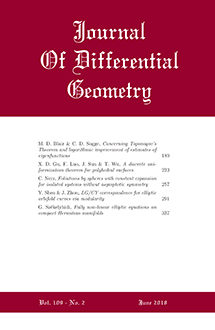Abstract
Given an Enriques surface $T$, its universal $\mathrm{K3}$ cover $f : S \to T$, and a genus $g$ linear system $\lvert C \rvert$ on $T$, we construct the relative Prym variety $P_H = \textrm{Prym}_{v, H} (\mathcal{D/C})$, where $\mathcal{C} \to \lvert C \rvert$ and $\mathcal{D} \to \lvert f*C \rvert$ are the universal families, $v$ is the Mukai vector $(0, [D], 2-2g)$, and $H$ is a polarization on $S$. The relative Prym variety is a $(2g-2)$-dimensional possibly singular variety, whose smooth locus is endowed with a hyperkähler structure. This variety is constructed as the closure of the fixed locus of a symplectic birational involution defined on the moduli space $M_{v,H} (S)$. There is a natural Lagrangian fibration $\eta : P_H \to \lvert C \rvert$ that makes the regular locus of $P_H$ into an integrable system whose general fiber is a $(g-1)$-dimensional (principally polarized) Prym variety, which in most cases is not the Jacobian of a curve. We prove that if $\lvert C \rvert$ is a hyperelliptic linear system, then $P_H$ admits a symplectic resolution which is birational to a hyperkähler manifold of $K3^{[g-1]}$-type, while if $\lvert C \rvert$ is not hyperelliptic, then $P_H$ admits no symplectic resolution. We also prove that any resolution of $P_H$ is simply connected and, when $g$ is odd, any resolution of $P_H$ has $h^{2,0}$-Hodge number equal to one.
Citation
E. Arbarello. G. Saccà. A. Ferretti. "Relative Prym varieties associated to the double cover of an Enriques surface." J. Differential Geom. 100 (2) 191 - 250, June 2015. https://doi.org/10.4310/jdg/1430744121
Information





